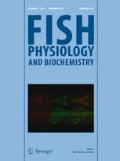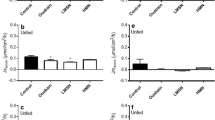Abstract
Intestinal fluid was collected from 11 marine teleost fish from the Baltic sea and the Pacific ocean. The anterior, mid and posterior segments of the intestine contained 33–110 mM of HCO3 − equivalents (with exception of the Atlantic cod which contained only 5–15 mM). Considering literature values of transepithelial potentials and concentration gradients, these high levels of HCO3 − equivalents are probably the result of active HCO3 − transport. Possible HCO3 − transport mechanisms were studied in the Pacific sanddab (Citharichthys sordidus) in vitro. Measurements of net secretion of HCO3 − equivalents across the intestinal epithelium revealed mucosal DIDS sensitivity (10−4 M) and Cl−-dependence of the HCO3 − equivalent net flux, but no serosal DIDS (10−4 M) sensitivity. Net Na+ uptake was abolished in the absence of Cl−, but some Cl− uptake persisted in the absence of Na+, at a rate similar to that of net HCO3 − secretion. Anterior, mid and posterior segments of the intestine performed similarly. These observations support the presence of an apical rather than a basolateral Cl−/HCO3 − exchanger and thus contrast the currently accepted model for intestinal HCO3 − secretion. This apical Cl−/HCO3 − exchanger alone, however, is not sufficient for maintaining the observed HCO3 − equivalents gradient in vivo. We suggest a coupling of cytosolic carbonic anhydrase, a basolateral proton pump and the apical Cl−/HCO3 − exchanger to explain the intestinal HCO3 − transport.
Similar content being viewed by others
References
Ando, M. 1990. Effects of bicarbonate on salt and water transport across the intestine of the seawater eel. J. Exp. Biol. 150: 367–379.
Ando, M. and Subramanyam, M.V.V. 1990. Bicarbonate transport systems in the intestine of the seawater eel. J. Exp. Biol. 150: 381–394.
Boutilier, R.C., Heming, T.A. and Iwama, G.K. 1984. Appendix: Physiological parameters for use in fish respiratory physiology. Fish Physiology Vol XA. pp. 403–430. (Edited byW.S. Hoar and D.J. Randell).
Cameron, J.N. 1971. Rapid method for determination of total carbon dioxide in small blood samples. J. Appl. Physiol. 31: 632–634.
Dixon, J.M. and Loretz, C.A. 1986. Luminal alkalinization in the intestine of the goby. J. Comp. Physiol. 156: 803–811.
Duffey, M.E., Thompson, S.M., Frizzell, R.A. and Schultz, S.G. 1979. Intracellular chloride activities and active chloride absorption in the intestinal epithelium of the winter flounder. J. Membr. Biol. 50: 331–341.
Grosell, M., De Boeck, G., Johannsson, O. and Wood, C.M. 1999. The effects of silver on intestinal ion and acid-base regulation in the marine teleost fish, Parophrys vetulus. Comp. Biochem. Physiol. C. 124: 259–270.
Grosell, M. and Jensen, F.B. 1999. NO-2 uptake and HCO-3 secretion in the intestine of the European flounder (Platichthys flesus). J. Exp. Biol. 202: 2103–2110.
Grosell, M. and Jensen, F.B. 2000. Uptake and physiological effects of nitrite in the marine teleost fish Platichthys flesus. Aquatic Tox. 50: 97–107.
Hviid Larsen, E., 1991. Chloride transport by high-resistance heterocellular epithelia. Physiol. Rev. 71: 235–283.
Hviid Larsen, E., Jensen L.J., Jespersen, Å., Møbjerg, N., Sørensen, J.B. and Willumsen, N.J. 1996. Chloride channels of mitochondria-rich cells in anuran skin: physiological significance and regulation. Zoology 99: 227–236.
Lombard, W.E., Kokko, J.P. and Jacobson, H.R. 1983. Bicarbonate transport in cortical and outer medulla collecting tubules. Am. J. Physiol. 244 (Renal Fluid Electrolyte Physiology 13): F289–F296.
Loretz, C.A. 1995. Electrophysiology of ion transport in the teleost intestinal cells. In: Fish Physiology Vol 14, Cellular and Molecular Approaches to Fish Ionic Regulation. Edited by C.M. Wood and T.J. Shuttleworth. Academic Press, New York.
Kirschner, L.B. 1991. Water and Ions. In: Environmental and Metabolic Animal Physiology: Comparative Environmental Physiology. Edited by Prosser, C.L. 4th Edition.Wiley-Liss, Inc., New York.
KcKinney, T.D. and Burg, M.B. 1977. Bicarbonate transport by rabbit cortical collecting tubules. J. Clin. Invest. 60: 766–768.
KcKinney, T.D. and Burg, M.B. 1978. Bicarbonate transport by rabbit cortical collecting tubules in vitro. J. Clin. Invest. 61: 1421–1427.
Nikinmaa, M. 1990. Zoophysiology: Vertebrate Red Blood Cells, Adaptations of Function to Respiratory Requirements. Springer Verlag, Berlin.
Smith, H.W. 1930. The absorption and excretion of water and salts by marine teleosts. Am. J. Physiol. 93: 480–505.
Smith, C.P., Smith, P.L., Welsh, M.J., Frizzell, R.A., Orellana, S.A. and Field, M. 1980. Potassium transport by the intestine of the winter flounder Pseudopleuronectes americanus: Evidence for KCl co-transport. Bull. Mt. Desert Island Biol. Lab. 20: 92–96.
Star, R.A., Burg, M.B. and Knepper, M.A. 1985. Bicarbonate secretion and chloride absorption by rabbit cortical collecting ducts. Role of chloride/bicarbonate exchange. J. Clin. Invest. 76: 1123–1130.
Walsh, P.J., Blackwelder, P. and Gill, K.A. 1991. Carbonate deposits in marine fish intestines: A new source of biomineralization. Limnol. Oceanogr. 36: 1227–1232.
Walton Smith, F.G. 1974. CFR Handbook of Marine Science. Vol I. CRC Press, Cleveland, OH.
Wang, Y., Henry, R.P., Wright, P.M., Heigenhauser, G.J.F. and Wood, C.M. 1998. Respiratory and metabolic functions of carbonic anhydrase in exercised white muscle of trout. Am. J. Physiol. 275 (Regulatory Integrative Comp. Physiol. 44): R1766–R1779.
Wilson, R.W., Gilmour, K.M., Henry. R.P. and Wood, C.M. 1996. Intestinal base excretion in the seawater-adapted rainbow trout: a role in acid-base balance? J. Exp. Biol. 199: 12331–2343.
Wilson, R.W. 1999. A novel role for the gut of seawater teleosts in acid-base balance. In: Acid-Base Status in Animals and Plants. pp. 257–274. Edited by E.W. Taylor, J.A. Raven and S. Eggiton. SEB seminar series 68. Cambridge University Press, Cambridge.
Wolf, K. 1963. Physiological salines for freshwater teleosts. Prog. Fish. Cult. 25: 135–140.
Wood, C.M., McMahon, B.R. and McDonald, D.G., 1979. Respiratory gas exchange in the resting starry flounder, Platichthys stellatus: A comparison with other teleosts. J. Exp. Biol. 78: 167–179.
Zall, D.M., Fisher, D. and Garner, M.D. 1956: Photometric determination of chlorides in water. Anal. Chem. 28: 1665–1678.
Author information
Authors and Affiliations
Rights and permissions
About this article
Cite this article
Grosell, M., Laliberte, C., Wood, S. et al. Intestinal HCO3− secretion in marine teleost fish: evidence for an apical rather than a basolateral Cl−/HCO3− exchanger. Fish Physiology and Biochemistry 24, 81–95 (2001). https://doi.org/10.1023/A:1011994129743
Issue Date:
DOI: https://doi.org/10.1023/A:1011994129743




